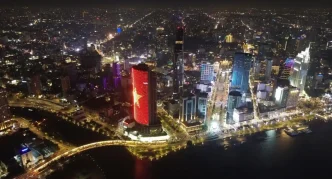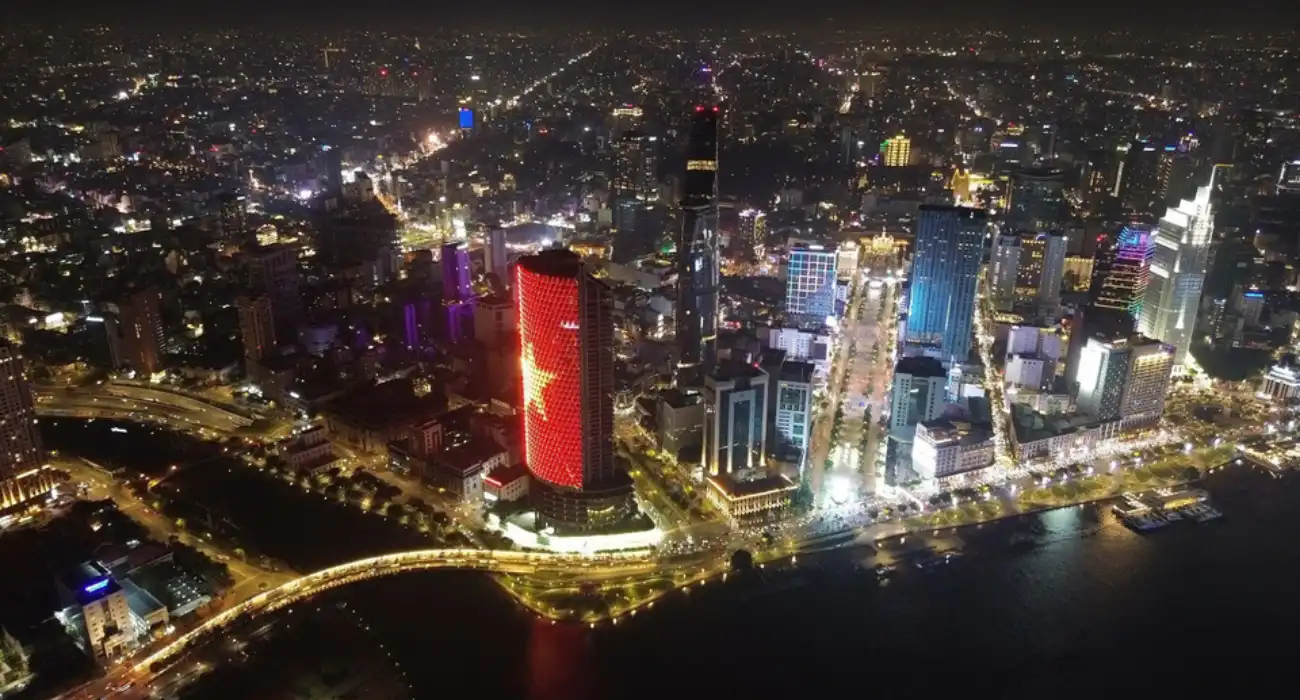Vietnam is staking US$13.2 billion to transform Ho Chi Minh City (HCMC) into an international financial centre (IFC) by 2030, signaling its ambition to liberalize and compete in ASEAN’s financial markets. With a government commitment comprising a US$7.2 billion budget and US$6 billion in tax revenue retention, alongside US$36 billion in targeted foreign direct investment (FDI), HCMC aims to rival Singapore and Bangkok. This pivot, inspired by Dubai’s DIFC, which generates 7.2% of the UAE’s non-oil GDP, could reshape Vietnam’s economy, but regulatory and structural hurdles loom large.
Funding Mechanics
Vietnam’s government is mobilizing substantial resources for HCMC’s IFC, centered on the Thu Thiem Financial and Trade Zone. Resolution No. 98/2023/QH15, enacted through Decree No. 259/2024/NQ-CP in January 2025, allocates US$1.2 billion annually from 2025 to 2030, totaling US$7.2 billion, for digital infrastructure, tax incentives, and talent development. This includes US$5 billion from a national US$20 billion public-private partnership (PPP) for green transition, funding Thu Thiem’s AI-driven trading platforms and blockchain exchanges. Additionally, HCMC’s new autonomy under Resolution No. 98 allows it to retain 50% of local tax revenue—up from 18%—yielding US$1 billion annually, or US$6 billion by 2030, for regulatory reforms and investor policies. The total government commitment is thus US$13.2 billion.
Private capital is critical. HCMC targets US$36 billion in FDI by 2030, building on 2024’s US$9.7 billion from firms like Samsung and Intel. Domestic conglomerates, including Vingroup and Techcombank, pledge US$1.2 billion by 2027 for fintech and AI startups, while global players like Visa, Mastercard, and Binance commit US$300 million in 2025 for blockchain and digital payments. The Ho Chi Minh City Economic Forum (HEF 2025), partnered with the World Economic Forum, highlights private-sector confidence. ‽web:2,5,18‽ref:2
Special policies bolster attractiveness: 7% corporate tax for fintech firms, 50% land lease subsidies, and visa-free entry for investors. These echo Dubai’s DIFC, which leveraged tax breaks to attract 5,000 firms. Yet, Vietnam’s fiscal capacity—public debt at 58% of GDP in 2024—constrains further commitments, and corruption risks, as seen in HCMC’s Metro Line 1’s US$2 billion overrun, could deter investors.
Economic Implications
HCMC, contributing 25% of Vietnam’s GDP, aims to reach 30% by 2030, diversifying from manufacturing (27% of GDP). Thu Thiem will integrate banking, capital markets, derivatives, and a digital asset exchange by 2028, capitalizing on Vietnam’s 7% annual GDP growth and 70% smartphone penetration. The stock market, at 44.7% of GDP in 2024, is projected to hit 120% by 2030, adding US$12 billion annually to GDP, per the HCMC People’s Committee. This could reduce exposure to global supply chain shocks, a vulnerability evident in 2020’s export disruptions.
The IFC is expected to generate 120,000 high-skill jobs by 2035—fintech developers, analysts, bankers—with urban wages rising 20%. This could stem brain drain to Singapore, where 10,000 Vietnamese professionals work. HCMC’s hub will enhance ASEAN competitiveness, potentially increasing regional trade by 10% through cross-border payment systems. Vietnam’s FDI inflows, up 12% in 2024, position it to capture capital flows, challenging Singapore’s 5.4% GDP financial sector share. “HCMC could anchor ASEAN’s financial integration,” says Le Hong Hiep, ISEAS-Yusof Ishak Institute. ‽web:2,16‽ref:3
However, returns are uncertain. Vietnam’s financial sector, at 6% of GDP, lags Singapore’s 13%. The IFC’s success hinges on regulatory clarity and infrastructure, with 30% of banks still using legacy systems. X posts reflect cautious optimism: “HCMC’s financial hub could be huge, but execution’s key.”
Policy and Regulatory Challenges
Structural barriers threaten progress. A 60,000-worker skills gap in finance and tech, with only 5,000 trained annually, constrains growth. The government’s US$100 million investment in coding bootcamps and partnerships (e.g., MIT fintech courses) is insufficient, with training cycles spanning 3-5 years. Regulatory delays are acute: crypto laws under Decree No. 94/2024/ND-CP remain in draft, deterring firms like Binance. Banking laws, rooted in 1990s frameworks, hinder digital integration, with compliance costs estimated at US$500 million annually.
Corruption is a persistent risk. HCMC’s Metro Line 1, initially budgeted at US$2 billion, cost US$4 billion due to mismanagement, eroding trust. X users voice skepticism: “US$13.2 billion won’t mean much if red tape wins.” Blockchain-based budget tracking is proposed, but adoption is slow. Political tensions also arise, with Hanoi resisting HCMC’s tax autonomy to protect northern revenue.
Da Nang’s US$60 million fintech hub, focusing on blockchain and USDT pilots, supports HCMC but lacks scale, with only 300 startups versus Thu Thiem’s 1,000 targeted firms.
Regional and Global Context
HCMC’s IFC aligns with ASEAN’s digital economy push, projected to reach US$1 trillion by 2030. Vietnam’s 65% digital banking adoption and 7% GDP growth give it an edge over Thailand (4% growth) and Indonesia (5%). Yet, Singapore’s financial sector, with US$2 trillion in assets under management, sets a high bar. HCMC’s 7% corporate tax undercuts Singapore’s 17%, but regulatory opacity and skills shortages erode this advantage. Bangkok, with a US$1.5 billion financial hub plan, is a closer rival, though its political instability weakens competitiveness.
Globally, HCMC’s ambitions are modest. Hong Kong, with a US$3 trillion financial market, is out of reach, but Dubai’s DIFC offers a blueprint for leveraging autonomy. Vietnam’s challenge is scaling financial depth—bank assets at 120% of GDP versus Singapore’s 600%. X posts highlight local ambition: “HCMC’s not Singapore yet, but it’s our turn.”
Policy Recommendations
Vietnam must prioritize regulatory reform to realize HCMC’s potential. Finalizing Decree No. 94/2024/ND-CP by mid-2025 would unlock US$1 billion in crypto investments. Modernizing banking laws, aligning with Basel III standards, could cut compliance costs by 20%. Tripling skills training to 15,000 professionals annually requires US$500 million more, potentially funded by redirecting manufacturing subsidies. Anti-corruption measures, like mandatory blockchain audits, are essential to rebuild trust, especially after Metro Line 1’s debacle.
HCMC’s autonomy under Resolution No. 98 should be expanded, allowing full tax retention to raise US$2 billion annually. Streamlining FDI approvals, which take 6-12 months, could accelerate US$36 billion inflows. Partnerships with Singapore’s Monetary Authority for fintech frameworks would enhance credibility, attracting US$5 billion in institutional capital by 2030.
Outlook
HCMC’s US$13.2 billion government investment, bolstered by US$36 billion in FDI targets, positions Vietnam to reshape ASEAN’s financial landscape. With 120,000 jobs and US$12 billion in annual GDP gains at stake, the IFC could elevate HCMC to Singapore’s league by 2035. Yet, without swift regulatory and skills reforms, Vietnam risks squandering its moment. As Dr. Nguyen Thi Thu Ha, HCMC University of Economics, notes, “HCMC’s success hinges on execution, not just ambition.” Vietnam must act decisively to turn Thu Thiem into ASEAN’s next financial frontier.
















